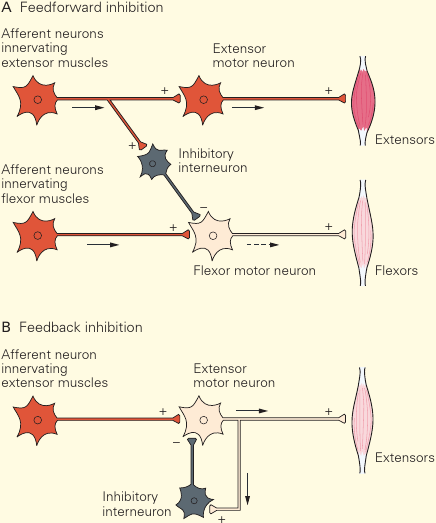Neuroscience
links: reference:
- https://biorender.com/
- Hille’s Ion Channels of Excitable Membranes - an 847-page atlas on all things electrophysiology. The titles are declarative like Andy Matuschak’s notes - interesting
- The Concise guide to Pharmacology 2013/2014
- Novel Players in the Aging Synapse: Impact on Cognition
- https://neuroskeptic.blogspot.com/
- https://en.wikipedia.org/wiki/Outline_of_the_human_nervous_system
- https://yewtu.be/channel/UC-x6Um1AmOxWbMTmxXDSjVw amazing videos on proteins involved in Synapses and stuff
- Youtube - Science With Tal - basic things like synapses and conductance with a computational leaning to it. Has a few gold videos but some are basic
- https://andrewtmckenzie.com/ just a cool blog
- https://med.libretexts.org/Bookshelves/Pharmacology_and_Neuroscience/Foundations_of_Neuroscience_(Henley) This one seems decent,
- https://neurotree.org/beta/index.php a family tree of lineages of neuroscientists. Moreso formally; not mere influence, I’m pretty sure. But what’s the difference sometimes?
- https://thebrain.mcgill.ca/index.php
- Stanford Psychedelic Science Group 6-12-2021
Neuroscience MOC #
- https://www.scaruffi.com/mind/ns.html
- Books I have in the library:
- Neuro/NEUROSCIENCE/NEUROCHEMISTRY/Basic Neurochemistry 7th Edition. Molecular, Cellular and Medical Aspects. George J. Siegel, R. Wayne Albers, Scott Brady, Donald L. Price, American Society for Neurochemistry 2005.pdf
- Modern figures; looks high tier actually. Plethora of protein schematics.
- Concise Learning and Memory: The Editor’s Selection (Elsevier 2009)
-
- Typology of Memory Terms
-
- Structural Basis of Semantic Memory
-
- Memory-enhancing drugs.
- etc.
-
- Newell’s Unified Theories of Cognition is pretty influential. Lead to the development of the “Soar” architecture. The mind is a singular system; not more discrete: “A single system (mind) produces all aspects of behavior. It is one mind that minds them all. Even if the mind has parts, modules, components, or whatever, they all mesh together to produce behavior… If a theory covers only one part or component, it flirts with trouble from the start. It goes without saying that there are dissociations, interdependencies, impenetrabilities, and modularities… But they don’t remove the necessity of a theory that provides the total picture and explains the role of the parts and why they exist.”
- Related: John Anderson’s Atomic Components of Thought (ACT-R) (1998).
- http://act-r.psy.cmu.edu/ they’ve got a list of publications going year by year. Some of them are looking pretty cool
- There are all these other acronym’d “theories of the brain” and whatnot. There’s REBUS: Altered beliefs under psychedelics: SEBUS, REBUS, ALBUS?
- Related: John Anderson’s Atomic Components of Thought (ACT-R) (1998).
- Consiousness Explaind by Denett.
- The disadvantage of Dennett is the same as that of Hofstadter. Both write so clearly that after reading their work it is difficult to imagine they might be wrong. I think both tend to be right, but I’m suspicious of how thoroughly convinced I am.
- Neuro/NEUROSCIENCE/NEUROCHEMISTRY/Basic Neurochemistry 7th Edition. Molecular, Cellular and Medical Aspects. George J. Siegel, R. Wayne Albers, Scott Brady, Donald L. Price, American Society for Neurochemistry 2005.pdf
- The Genetic Architectures of Functional and Structural Connectivity Properties within Cerebral Resting-State Networks
- [Brain functional connectivity mirrors genetic pleiotropy in psychiatric conditions](Brain functional connectivity mirrors genetic pleiotropy in psychiatric conditions)
- https://en.wikipedia.org/wiki/Integrative_neuroscience?useskin=vector good subfield. works to unify functional organization data to better understand complex structures and behaviors. The relationship between structure and function, and how the regions and functions connect to each other. Different parts of the brain carrying out different tasks, interconnecting to come together allowing complex behavior
-
https://en.wikipedia.org/wiki/Molecular_cellular_cognition?useskin=vector good subfield. Observes how molecular (indeed, mostly nootropics-adjacent topics; mostly small molecule things) and cellular processes (including inter-, like networks) modulates cognitive function
- https://www.routledge.com/Cognition-Based-Evolution-Natural-Cellular-Engineering-and-the-Intelligent/Miller/p/book/9781032261478 post-neodarwinism: introducing the senome (sum of a cell’s information), holobionts, and some boring stuff. Might be good to read a few chapters
- Ok neuroscience papers you would consider game changers published AFTER 2010, go
Videos #
- Lectures on Youtube are underrated, since they explain it in a more casual way to account for the diverse yet sophisticated audience.
- Artem Kirsanov - My Strategy To Consume Information Effectively makes a pretty damn good case for using the ShortForm extension (only on Chrome…) for summarizing on the side to augment the scrubbing. Not only does this work with videos but also articles.
- Elliot Nicholson - Biochemistry
- Cellular Mechanisms of Brain Function (2016) big youtube course with an emphasis on the physiological side of things. Pretty canonical; this would be a good course
- (MITCBMM) The Center for Minds, Brains and Machines
- https://www.youtube.com/user/InquilineKea/playlists
Syntopic Workspace #
-
Synaptic facilitation: acute increase in synaptic response (vesicular release) with rapidly occuring APs due to Ca2+ accumulation in presynaptic terminal
-
GPCRs in the desensitized state often exhibit higher agonist affinities than the open state. Correlation or causation? Or does that not apply
-
https://www.reddit.com/r/NooTopics/comments/t4r9h1/the_complete_guide_to_dopamine_and/
- CREB -> ↑dynorphin → dopamine release inhibition. How prevent? The power of ALCAR is that it doesn’t promote CREB, but that it acetylates proteins deacetylated by HDAC1 (effectively blocking the downregulatory effect of ΔFosB on c-Fos).
- Enkephalins prevent downregulation of the D1 receptor via RGS4 (teminates μ signaling), leading to preferential downregulation of D2.
- Will be an important read for Striatum CREB/DARPP-32, etc.: @Signaling in Striatal Neurons The Phosphoproteins of Reward, Addiction, and Dyskinesia (Girault 2012)
-
Vmax is the maximal reaction rate or velocity of an enzymatically catalyzed reaction when the enzyme is saturated with its substrate.
- ()
- At a specified enzymatic concentration, temperature & pH, this maximal rate of reaction is the characteristic feature of a particular enzyme. The Vmax unit is moles/min, moles/sec, µmoles/min, or µmoles/sec. Vmax
KevinBinz/Fewer Lacunae #
-
https://kevinbinz.com/2017/04/26/social-behavior-network/
- The SBN is anatomically related to the basal ganglia, and is strongly connected with its limbic loop:
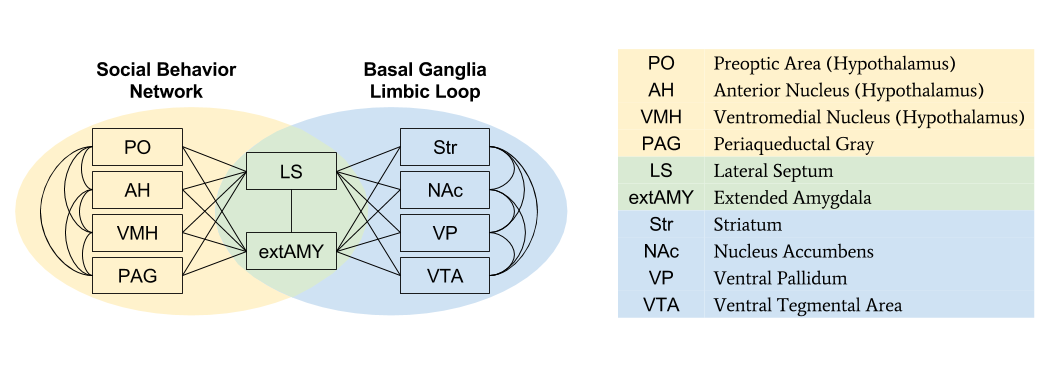
- Neuroscientists studying aggression, parental care, and sexual behavior all independently identified six brain regions that seem to produce this behavior. They are:
- Preoptic Area of the Hypothalamus (PO)
- Anterior Nucleus of the Hypothalamus (AH)
- Ventromedial Nucleus of the Hypothalamus (VMH)
- Periacquductal Gray (PAG)
- Lateral Septum (LS)
- Play as well, possibly.
- Extended Amygdala (extAMY)
- The SBN is anatomically related to the basal ganglia, and is strongly connected with its limbic loop:
RemodeledBrain #
- https://remodeledbrain.com/
- https://www.reddit.com/r/remodeledbrain/comments/xft2mq/neurotransmitters_as_training_chemicals/ neurotransmitters are traffic signals. Peptides are the real building blocks.
Essential Neuroscience #
I Gross Anatomy #
- Ipsilateral: On the same side with reference to a specific point; controlateral the opposite
- Nucleus: just a congregation of neurons that all fulfill the same function, appearance, input, output, etc.
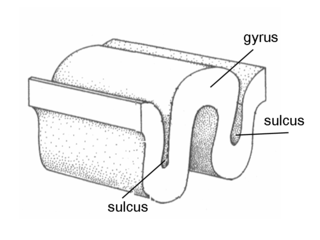 There are also cavities in the hemisphere known as ventricles, which contain Cerebrospinal Fluid, which is secretd from epithelial cells
There are also cavities in the hemisphere known as ventricles, which contain Cerebrospinal Fluid, which is secretd from epithelial cells
Neuronal Development/Generation/Death #
- The neural tube is the embryonic precursor to the CNS.
- Prenatal folate deficiency prevents appropriate cell turnover and neural tube closure.
- BMP also controls neural tube induction.
- Axon Guidance
3. Meninges & Cerebrospinal Fluid #
There’s the Blood Brain Barrier, blood-CSF barrier, brain-CSF barrier, and CSF-brain barrier!
II The Neuron (pg 58) #
Mitochondria are found in both the soma and neurites. Makes sense yeah
- Three types of axonal transport (NOT synaptic transmission): fast/slow anterograde, and fast retrograde.
Electrophysiology #
-
Hydrophobic/nonpolar substances, and small, uncharged polar molecules (CO2, C2H6O, water) - they pass through the neuronal membrane via simple diffusion - no energy required.
- These solutes move from regions of high concentration to low, which makes the concentration gradient, determining the direction of movement.
-
Channel proteins (and some carrier proteins) mediate passive transport through them, where still no energy is required.
-
Carrier proteins mediate active transport where energy (i.e. ATP Hydrolysis) is required.
-
Fixed anions within the cell make the membrane negative relative to the outside. Therefore, cations like $\ce{Na+}$ can enter, but anions cannot, requiring active transport proteins such as Na+K+ ATPase to bring it against the electrochemical gradient.
Ion Channel #
-
Energy flow is passive, in that it requires no ATP. Instead, it’s a matter of ligands or voltage gating.
-
There are always-open ’leak channels’ that contribute to the resting potential.
-
The ‘voltage-gated ion channel’ is an individual thing appart from ionotropic receptors (maybe used for simple interneuron-like circuit activity as maybe it’s kind of like a transistor).
- Voltage-Gated Ion Channels and Electrical Excitability: In the computer metaphor of the brain, the voltage-gated ion channels are like the transistors of logical circuits…
-
Ligands on ligand-gated channels bind noncovalently. I wonder what this “binding” actually is - just van der Waals? Seems like it can be complex to create (though automated these days) to design a ligand (i.e. drug) for something if you’re just going off a pocket in a protein or something. Very interesting.
-
Ionotropic = directly gated. Each subunit contains four alpha helices:
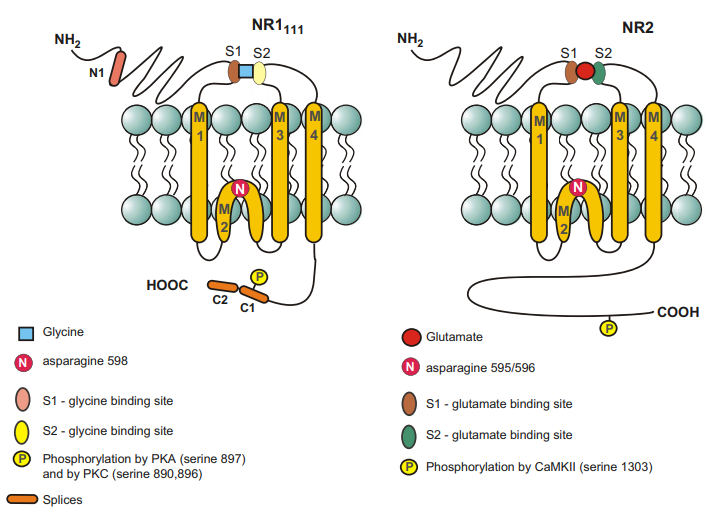
-
Metabotropic = indirectly gated, since ion channel and recognition site are separated.
Synaptic Transmission #
- Most synapses in the mammalian NS are bidirectional/nonrectifying.
- For chemical synapses, it’s not a gap junction but instead a synaptic cleft of ~20-50nm.
- They adhere to each other due to matrix of extracellular fibrous protein, like neurexin… which like never depicted. It’s also hard to find a source on what exactly is actually between the synapses on say a dendrodendritic connection. It’s not like it’s a vacuum. Just Cerebrospinal Fluid?
Neurotransmitters #
Exocytosis etc. #
- To be a neurotransmitter proper, it must be synthesized in the neuron by enzymes in the neuron.
- That means Glycine must somehow be sythesized in the NMDA neuron? Indeed: Serine is formed from 3-phosphoglycerate, which turns into glycine via serine transhydroxymethylase AKA serine hydroxymethyltransferase.
- Hyperglycinemia (loss of transpoters needed for its removals) is characterized by mental retardation and lethargy
- That means Glycine must somehow be sythesized in the NMDA neuron? Indeed: Serine is formed from 3-phosphoglycerate, which turns into glycine via serine transhydroxymethylase AKA serine hydroxymethyltransferase.
So after Kinesin brings the vesicle to the synaptic cleft, what happens?
 bruh.
bruh.
- This chapter is only talking about Ca2+ with regards to this stuff: Depolarization of the presynaptic membrane from Na+ results in opening of VGCCs. Ca2+ then activates synaptotagmin, promoting fusion of the vesicle and membrane. Then, an opening is formed and the vesicle’s contents are released: exocytosis. SNARE proteins, synaptobrevin …yeah maybe another day.
Synapses #
-
This is cute I guess. They’re all slightly different but I guess I’ll save the images for other uses and not mess with em.
- Take note of how some of these enzymes are just chilling in the presynaptic terminal while others only appear to exist in the mitochondria or in astrocytes.
-
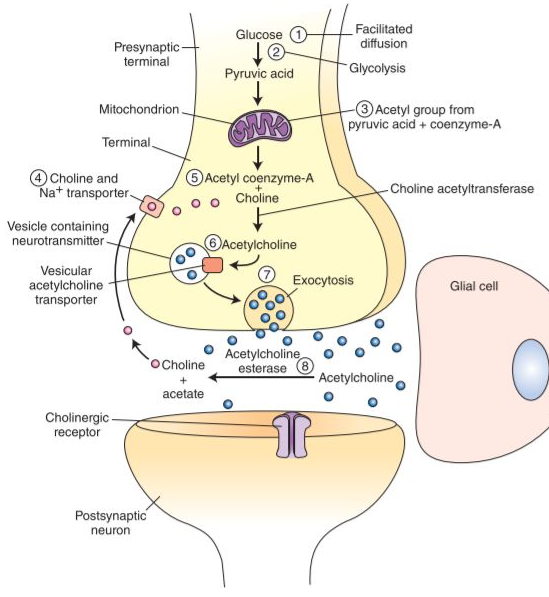 neuron-a
neuron-a

-
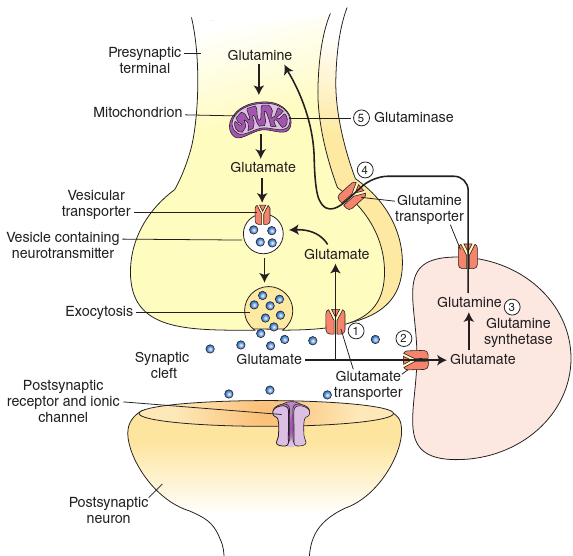
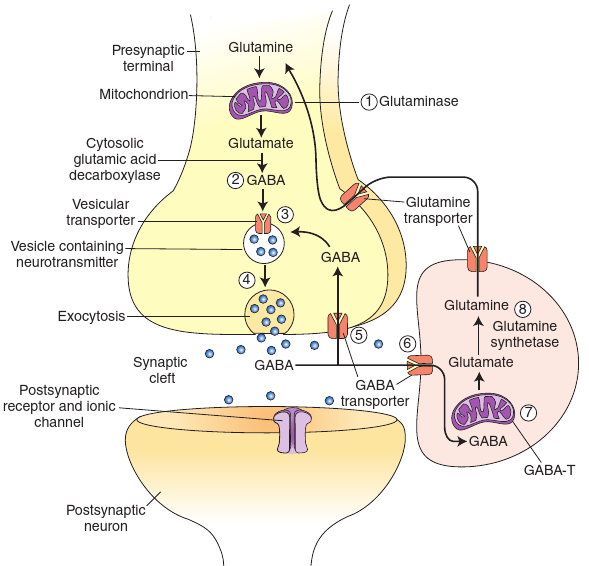
- Yeah glutamic acid can be ingested and all that, but it is also synthessized from α-Ketoglutarate (AKA, in this book, α-oxoglutarate) via alanine transaminase.
- It’s also converted from Glutamine (glutamic acid + ammonia) via Glutaminase (in the mitochondria as well) while Glutamine Synthetase breaks down Glutamate into Glutamine after being picked up by the Glutamate Transporter found on astrocytes/terminal presynaptic membrane:
- I wonder how much of ingested glutamic acid just converts right to Glutamine.
- Yeah glutamic acid can be ingested and all that, but it is also synthessized from α-Ketoglutarate (AKA, in this book, α-oxoglutarate) via alanine transaminase.
-
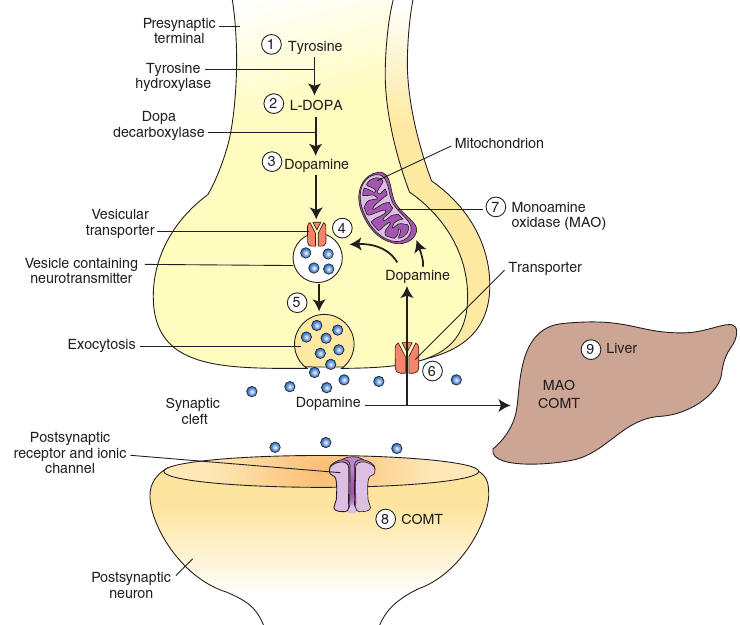
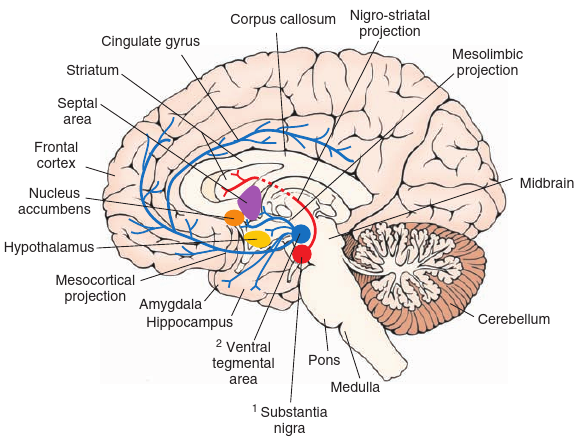
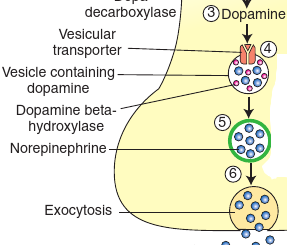
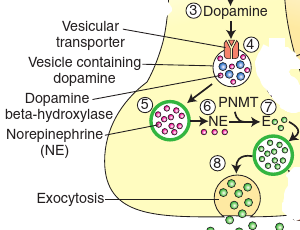
- ~50% of the dopamine taken up by DAT (reuptake-1) is retransported into vesicles.
- Interesting how dopamine apparently must exist in the synapse via a vesicle, and it’s only if the vesicle additionally contains Dopamine β-hydroxylase that it converts to Noradrenaline.
- YET, it leaves the vesicle to get hit by PNMT only to… reenter it???
-
Serotonin:
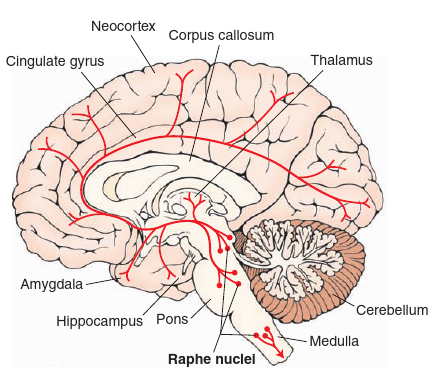
-
Histamine does not cross the BBB.
Peptides #
-
Endorphins -> β-endorphin, made via -> Pre-proopiomelanocortin -> proopiomelanocortin, makes -> melanocyte-stimulating hormone, which activates -> Melanocortin Receptors, just like Semax. I will continue with this grand synthesis + anki in the morning. Interesting stuff. Travis has plenty to say about endorphins and by extension who knows, so this will be a great place to branch out after this little section: https://raypeatforum.com/community/threadloom/search?query=endorphin%20user:%22Travis%22&tab=379
-
Pre-propeptides are synthesized in the Rough Endoplasmic Reticulum via the original gene (like pre-proInsulin’s is INS). Still during translation in the RER, the ‘signal peptide’ on it is cleaved (via signal peptidase) and they become propeptides, which is transported via vesicles (they must be crammed sometimes) to the terminal where it can then be further proteolyzed into all kinds of stuff.
- So basically S-B-C-A -> B-C-A -> $\underset{C}{B-A}$ (In the case of insulin)
- The vesicles can also contain enzymes that proteolyze it during transport (immature->mature vesicles).
III Organization of the CNS (138) #
We made it
Forebrain #
VI Integrative systems (386-536) #
Hypothalamus #
Limbic System #
Hippocampus #
Thalamus & Cerebral Cortex #
Purves’ #
I Neural Signaling #
1. studying the nervous system #
2. electrical signals of nerve cells #
3. voltage-dependent membrane permeability #
4. ion channels and transporters #
5. synaptic transmission #
6. neurotransmitters and their receptors #
7. molecular signaling within neurons #
8. synaptic plasticity #
II Sensation and Sensory Processing #
III Movement and Its Central Control #
IV The Changing Brain #
V Complex Brain Functions and Cognitive Neuroscience #
Principles of Neural Science #
- Principles" is solid and standard. It is cautious when approaching a recently-discovered concept. This property will lead to a remarkable lifespan for this textbook.
- Perception, sensation, and movement were not the reasons that I first became interested in neuroscience, and, generalizing from my one example as is de rigueur in book reviews, I think that is true of most students. And while this might be just Stockholm syndrome, I’m actually quite happy that there is so much detail and care put into these sections which make up around 1/3rd of the text. These fields are way more tractable to study than the sexy emotion, learning, and personal identity … I prefer my pedagogical material to be structured in the format of example 1, example 2, (optional example 3), and ‘inducted principle’. The examples only matter insofar as they motivate the principles. Kandel’s textbook strays slightly too far from this, I think. In particular, the text tends to enshrine the examples, such CREB, CamKII, PKA, and the ilk, as worthy of our worship in and of themselves. This sets the trend for how neuroscience courses should be taught and for that reason it is a bit troubling.
I Overall Perspective #
Nerve Cells #
III Synaptic Transmission #
- An autoimmune disorder in which the production of antibodies to the NMDAR reduces levels of the receptor in the membrane. Individuals with this disorder often experience severe seizures, most likely a result of the loss of inhibitory tone because of a reduction in ==NMDA receptor excitation in GABAergic Interneurons,== as well as psychoses, including hallucinations and other symptoms resembling schizophrenia… recent genome-wide linkage analysis suggesting an association between the NR2A gene and schizophrenia.
Modulation of Synaptic Transmission and Neural Exccitability: Second Messengers #
Sheeeeesh. I’ve been working on these GPCRs/PI3K for days!
-
I guess it just hit me that all metabotropic receptors need to open membrane channels. PKA can go on to phosphorylze all kinds of things like enzymes to synthesize NTs. Even tho it’s on ‘postsynaptic’ - which is essentially just a relative term.
-
While Gαs-GTP is deactivated by the GTPases, it still gets to activates AC; the following cascade terminates by many other means. cAMP is deactivated (into AMP) by PDE - but it gets to activate PKA still, whose actions are undone by Protein Phosphatases.
VIII Learning, Memory, Language and Cognition #
Learning and Memory #
The Hippocampus and the Neural Basis of Explicit Memory Storage #
The prefrontal cortex mediates working memory. Information from working memory can be stored elsewhere as long-term memory, which requires the hippocampus - but the ultimate storage site for most declarative memoy is thought to be the cerebral cortex. Thus, “memory” is intrinsic to many, many brain areas.
Corneliu #
- We wish to orient higher brain integrative activity, and this term was coined by Sherrington in 1906: “The ensemble of those CNS-processes that combine “elementary reflexes into movement patterns having obvious purposes”
-
Sir Charles Sherrington’s the integrative action of the nervous system: a centenary appreciation
- Neuron doctrine vs. the Reticular Theory, which was popularized by Golgi but postulated by Joseph von Gerlach. (Golgi and Ramon y Cajal both got the nobel prize in medicine even though their theories were competing) The idea is that the brain is a single continuous network rather than discrete cells.
-
Sir Charles Sherrington’s the integrative action of the nervous system: a centenary appreciation
Buzsaki #
- https://buzsakilab.com/wp/research/ Buzsaki also wrote a 2015 monograph, and a few reviews around neural oscillations. And research articles.
Rhythms of the Brain (2006) #
Brain from Inside Out (2019) #
- Most of the terms that form the basis of today’s cognitive neuroscience were constructed long before we knew anything about the brain, yet we somehow have never questioned their validity. - it seems this is the crux of the book and exacly what made it seem interesting.
- The core argument of this book is that the brain is a self-organized system with preexisting connectivity and dynamics whose main job is to generate actions and to examine and predict the consequences of those actions. This view—I refer to it as the “inside-out” strategy—is a departure from the dominant framework of mainstream neuroscience, which suggests that the brain’s task is to perceive and represent the world, process information, and decide how to respond to it in an “outside-in” manner.
- Perceptual dualism sees its origin in Aristotle, with the explanandum (that which requires explanation) and explanan (explainer).
- Brain responses do not intrinsically “represent” stimuli until the experimenter interprets the data.
- https://docs.google.com/document/d/1txrkgDj1eFY1_t0GuEPlsUOCObbuHsPSUTw9iDf3Auw/edit#heading=h.helwxn5r1vec Pretty brief notes from a bunch of grad students. Also has “further reading” of a few articles for relevant related stuff
6. Brain Rhythms Provide a Framework for Neural Syntax #
Indeed, the circuits in the brain are not binary, as receptors can differentiate (or at least, do respond differently) between tonic and phasic. I suggest that neuronal rhythms provide the necessary syntactical rules for the brain so that unbounded combinatorial information can be generated from spike patterns.
- Cross-frequency phase modulation: The phase of slower oscillations modulate the amplitudes of the faster
- Cross-frequency coupling: The interactions between distinct frequency bands.
- Phase-phase coupling, amplitude-amplitude coupling, and phase-amplitude coupling.
- Cross-frequency coupling: The interactions between distinct frequency bands.
7. Internally Organized Cell Assembly Trajectories #
8. Internally Organized Activity During Offline Brain States #
9. Enhancing Brain Performance by Externalizing Thought #
10. Space and Time in the Brain #
Fundamentals of Brain Network Analysis #
2. Nodes and Edges #
Systems Neuroscience #
- Finally: Systems neuroscience is what I want to learn about I think. Frontiers
-
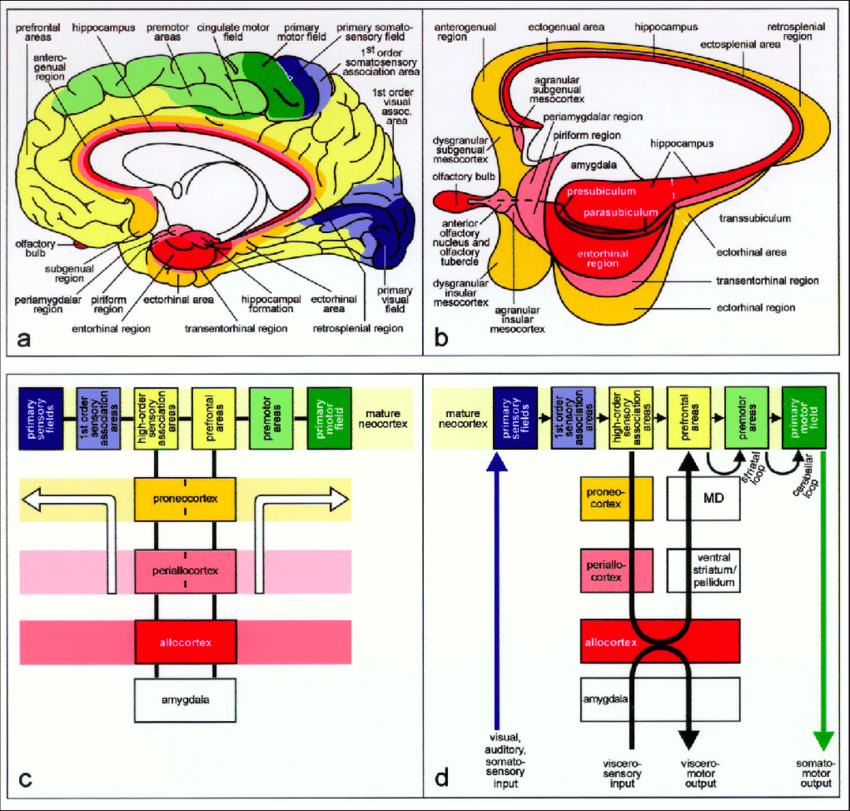
- I probably have a few of these in the vault, but I don’t know - I think something broad and ground up like this definitely deserves its own page. But I don’t know if this is at conflict with Neural Circuits. Perhaps that’s for specific ones like the VTA, rostral migratory stream, etc.
- Hippocampus
Range & Dale #
- A prerequisite for an inverse agonist response is that the receptor must have constitutive/intrinsic/basal level of activity - that is, activity in the absence of a ligand.
